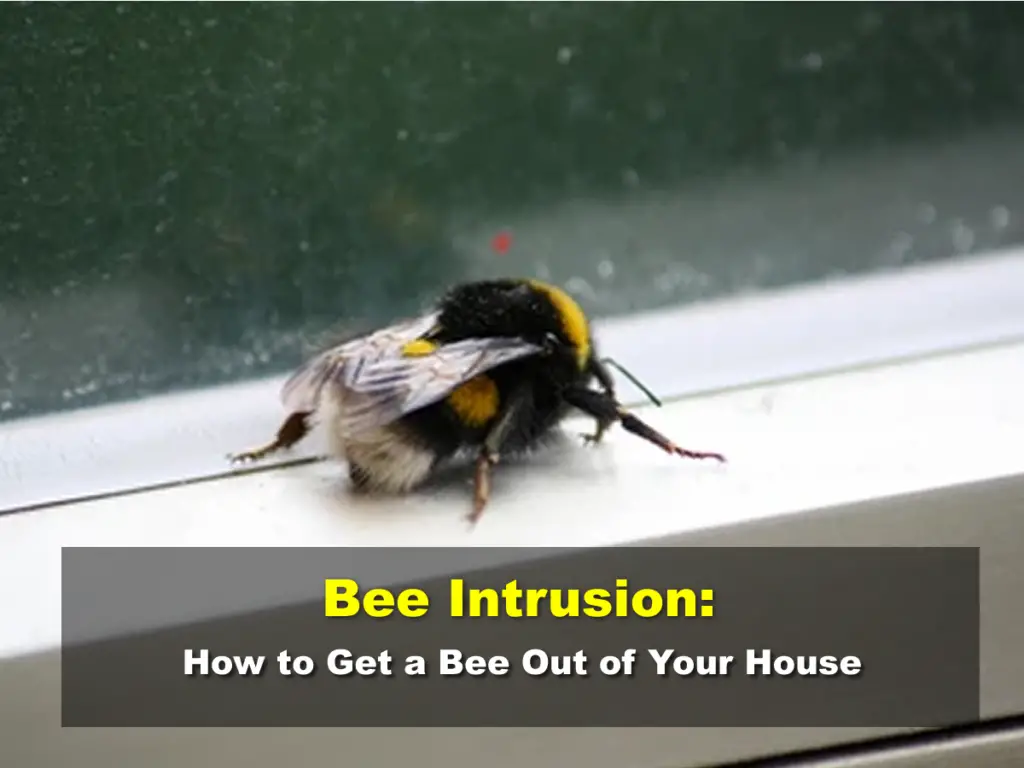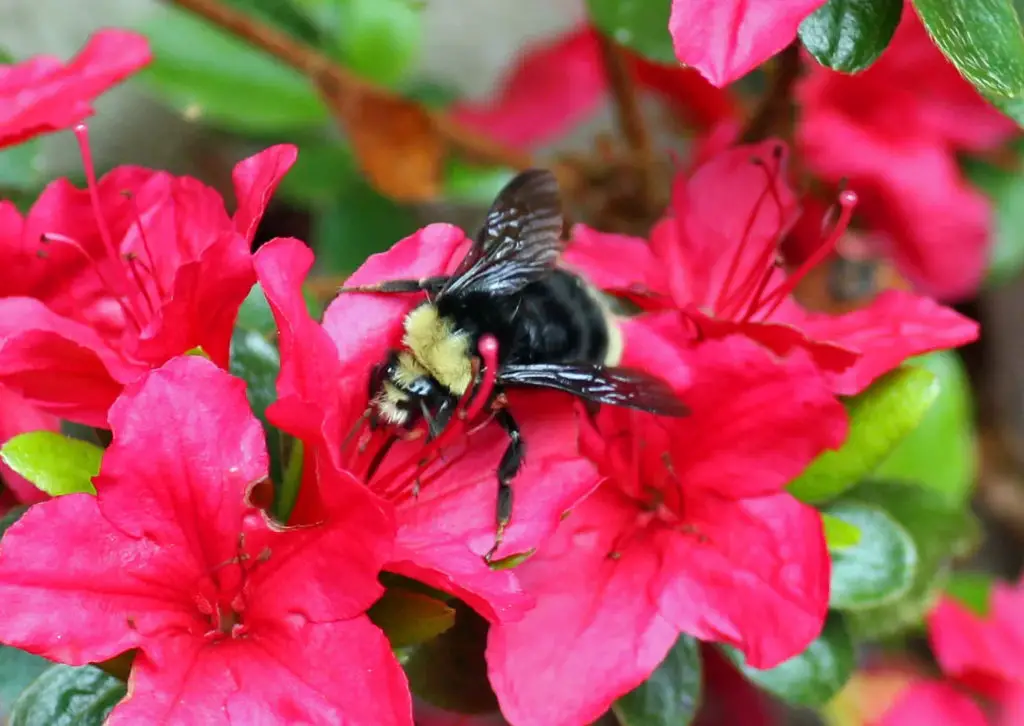Affiliate Disclaimer - As an Amazon Associate I earn from qualifying purchases.
It supports the website. So, Thank you
For the most part, bees are pretty harmless and they’re more interested in going about their business than they are stinging you. In fact, some bees don’t even have stingers so they’re even safer.
That said, you probably don’t want to share your home with insects so if one flies in, you’re left wondering how to get a bee out of your house.
The easiest way to get rid of the bee is to open the doors and windows and allow it to fly out of its own accord. But if that doesn’t work, there are several other methods you can use such as luring it out with sugar syrup or repelling it with citronella and other bee-deterring scents.
If you’re reading this guide with a pesky bee buzzing around your living room, then don’t worry; we’ll have it out in no time.
What’s The Best Way To Get A Bee Out Of Your House?
It’s quite common in summer for homeowners to leave their doors and windows open, allowing air to flow through the house and keep it from getting too hot and humid.
But with the house open to nature, it’s also not uncommon for bees to fly inside to explore.
Before you start panicking, keep in mind that the bee probably doesn’t want to be inside your house as much as you don’t want it there. In fact, it may have entered accidentally and is now frantically searching for a way out.
So, what can you do to help?
Keep those windows and doors open, of course. Hopefully, the bee will find its own way out and buzz off to find flowers. The more windows and doors you can open, the better.
I sometimes find that, if a bee is flying around an open window but can’t quite locate the opening, giving it a helping hand is useful. I usually take a piece of paper to gently guide the bee to where it needs to be. But of course, you need to be very careful not to upset it when doing this as it may cause it to sting as a result of feeling threatened (the bee doesn’t know you’re trying to help it!)
Other Methods Of Bee Removal From Your House
If you haven’t been successful in getting rid of the bee through an open door or window then there are plenty of other ways you can try to make it leave.
Use Sugar Water To Trap The Bee
A great way to safely remove a bee from your home is to trap it in a jar or container and release it back outside.
You may be wondering why a bee would voluntarily land in a container but that’s where you need to be smart and add something to lure it in.
Sugar water is the best option as this is the closest thing that resembles nectar; a bee’s natural food source. Simply mix equal parts sugar and water and put the mixture into your container.
Leave the container close to where the bee is and wait for it to investigate. This shouldn’t take long as bees are suckers for a sweet treat. Once it is inside, pop the lid on and take the container outside.
Repel The Bee With Scents
There are certain smells that bees just cannot stand and using these around the house could be enough to send your unwanted guest packing.
Citronella is a great choice and can be burned in the form of a candle. Just light the candle in the room with the bee, leave the window open, and wait for it to fly away.
Alternatively using essential oils such as peppermint or eucalyptus have a similar effect. If you don’t have these, you could try boiling garlic in water and leaving the resulting mixture in the room with the bee. Even garlic powder will have an effect.
Bees also cannot stand the smell of vinegar but I should issue a word of caution with this one as vinegar can be lethal to bees because of the acetic acid. So, if you want to remove the bee humanely, this may not be the best choice.
Lure The Bee Outdoors
The bee in your house might be having a hard time finding its way outside but you could provide some sort of direction with a sweet-smelling lure.
Something like the sugar water I talked about earlier will work well, as will freshly cut fruit, like mango, placed strategically outside the door might be enough to attract it.
Once the bee is outside, you can shut the doors and you have your home back to yourself. Of course, it’s not a good idea to leave the fruit directly outside the house once the bee has left so I would recommend removing it as soon as the bee loses interest and flies away.
What To Do If Bees Are Nesting In Your Walls
Sometimes bees will nest in the walls of a house and this can be incredibly tricky to treat. It is worth keeping in mind that most solitary bee species will complete their life cycles and move on. So, if you can put up with them for a little while, then they’ll leave soon.
But let’s be realistic, most people aren’t looking for insect lodgers, no matter how quickly they may move on.
First, you need to locate the nest and then it’s a matter of removing it and its residents. However, when the bees are in a wall, this can be very tricky so most homeowners find it a better option to call a pest controller.
If you do want to handle the problem yourself then one of the first things you’ll need to do is seal the entrance to the nest. It’s best to do this when most of the bees are out foraging as they’ll struggle to get back in. What’s more, you won’t have a number of dead bees stuck in your wall that you’ll need to remove at a later date.
Once all of the bees have gone or died inside the sealed nest, you will need to remove all remnants of the nest as it can contain pheromones that could attract more bees to the area.
Can’t I Just Kill The Bee?
If you find a bee in your house then I’d strongly recommend trying to remove it without harming it. I know that a lot of people are scared of bees and if we were talking about a spider, I’d be asking exactly the same question.
But we’re not talking about spiders, we’re talking about bees and these are extremely beneficial insects (so are spiders because they control fly populations but that’s a topic for another day.)
Bees are among the most important pollinators on the planet and are responsible for the pollination of as many as 75% of human crops as well as many wildflower species. Without bees, the world would look very different so it’s imperative that we all do our bit to protect them.
The only time I would condone removing a bee by killing it would be if it posed a serious risk to your health. For example, if there is someone in your home with a severe allergy or the bee is showing heightened signs of aggression. But even in these cases, it’s best to try alternative methods before ending its life.
Safety Considerations
As I mentioned above, there are some people who suffer from a bee sting allergy and in some cases, these allergies can result in a fatal reaction.
If you or anyone that lives in your home has a bee allergy then that person should be removed from the situation while the insect is dealt with. This can be as simple as the person going into another room and shutting the door until the bee is gone. It’s just not worth risking a potentially lethal sting.
Even for those that aren’t allergic to bee stings, they can still be painful and unpleasant so something you’ll want to avoid.
When handling bees or attempting to remove them, it’s a good idea to wear protective gear like gloves and eye goggles. This might sound extreme but you’ll thank me later.
Moreover, it’s worth learning the signs that bees display when they’re agitated. Bees don’t attack humans for no reason and typically only sting when they feel threatened. But before this happens, they’ll show other signs that act as a warning such as zipping movements and flying around your head.
When dealing with bees, only ever make slow, controlled movements and don’t ever move suddenly as this could be seen as a threat.
Final Thoughts
Bees aren’t generally dangerous creatures and they’re not interested in humans. However, from time to time our paths cross and a bee may end up in your home. The good news is that the bee probably doesn’t want to be there and there are many methods for how to get a bee out of your house that are quick and effective.
Just remember to be safe around the bee and keep in mind that there is always the potential for a sting.




